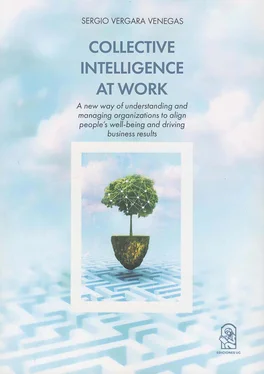The evolutionary model of organizational climate is based on the concept of collective intelligence described in Chapter 1. This concept in fact transcends the organizational climate and has implications for multiple social and collective processes; for example, safety at work and the processes of dialogue and social understanding, which are not the subject of this book.
The evolutionary model considers organizational climate management from a perspective involving three dimensions:
1. The business dimension considers all the variables associated with the management of the business unit (or management unit, which will be considered synonymous for the purposes of this book). This dimension groups together all the variables linked to management, i.e., the way in which it is conducted and directed. As we shall see, there is a wide range of variables in this dimension that affect climate. For example, many unsatisfactory group dynamics are the result of poorly defined processes with unclear roles, which lead to a feeling of unfair treatment and strained relationships. Similarly, work overloads that cause great discomfort and a feeling of unfairness are the result of an insufficient structure or one that needs to be redefined. The management dimension is often not very visible, i.e., although it has an enormous impact on the organizational climate, it is not usually perceived directly by people, which means that in many cases action plans do not consider addressing this dimension.
2. The group dimension incorporates all the relational dynamics between the parties involved in the organizational climate: managers, , leaders, teams, and Human Capital Management. The group dimension is not the sum of the characteristics of the individuals. This dimension is essentially systemic, and addressing it implies taking perspective to understand relationship dynamics where the parts move in relation to each other.
One of the key aspects to consider here is the differentiation between the role and the person. That is, those involved must be able to understand the implications of their role within the entire system, so that managers, supervisors, and employees can identify how they contribute to making the work and the organizational climate more productive, but from the role that each one plays, and learn to do it effectively. A manager or supervisor who behaves in all areas as a peer of their employees may generate closeness, but at the same time will cause issues that affect people to go unanswered. An employee who, on the basis of “being spontaneous,” does not take a constructive (even critical) stance when expressing their views in group meetings, will not be collaborating to progress.
3. The individual dimension considers the variables linked to individuals separately. That is, individual performance and personal attitudes. Trends can be obtained by summing up the set of attitudes that are mostly observed in individuals, but these cannot be confused with the group behavior, which is more than the sum of its parts. This is the most essential and basic dimension, from which all change has to start, from people’s commitment and attitude.
Given that it is the most visible of all the dimensions, the challenge is to not reduce work on organizational climate to only personal commitment. Committed people, who have no clarity about the role they play in improving the climate and without the capacity to exercise it, will not bring about sustainable change.
In the author’s experience, addressing the management of the organizational climate in a sustainable manner requires comprehension and intervention in all three dimensions. Often the approach is based on the individual dimension, which is the most visible one, but it leaves out key variables linked to the management model such as the processes, policies, roles, and structure, which, as we will see in the following chapters, can have a great impact on the organizational climate, even though they are often invisible or blurry to those involved. The same is true of issues linked to team dynamics and teams’ ways of operating, which involve a broader dimension than the sum of individual behaviors.
The evolutionary model also incorporates the vision of maturity, which is the notion that human processes transform over time, becoming more solid and firmly sustained. This consequently shows that the role of leaders is to encourage maturity in the dynamics and make the organizational climate evolve, opening up new possibilities for action and understanding.
This book explains the evolutionary model in depth. Its purpose is to provide new perspectives for understanding and managing the organizational climate, which lead to new questions and thus new answers beyond those already known. Some exercises and tools are also included so that readers can draw their own conclusions. To support this process, I have incorporated examples from our experience working with different types of organizations in which we applied the evolutionary model with the Partners & Success team.
This book is primarily aimed at executives and managers who wish to achieve significant improvements in their organizational climate and provides them with a set of tools and concepts so they can do this on their own. It is also of great value to all those involved in the world of people management and organizational change, as the book outlines how to make joint interventions between executives and the staff or the support role of Human Capital.
Chapter 1 focuses on what the author defines as collective intelligence and the process to build it, which is part of the foundation of the evolutionary model. It also shows the key principles of the evolutionary model. Chapter 2 explains that the organizational climate should be understood as a relationship. Chapter 3 elaborates on how to look at the work dimensions from the most to the least visible dimension. Chapter 4 gets into the responsibility that falls to each role in improving the organizational climate. Chapter 5 explores one of the most fundamental concepts of the model: the notion of maturity. This refers to the evolutionary nature of the organizational climate, a concept that opens up a set of possibilities by outlining what is advisable to do and what is not, depending on the organization’s level of maturity at any given moment. This topic is discussed in greater depth in Chapter 6, which identifies the levers that the organization and the leader can use to generate maturity in the process.
Chapter 7 delves into the variables considered indispensable not only to have a good organizational climate, but also to avoid occupational risks well in advance, by means of the survey and the organizational climate management plan. Chapter 8 addresses the difference between work dynamics and work practices and provides concrete tools to identify dynamics and improve them through effective practices. Chapter 9 develops the work environment intervention control panel, which is intended to serve as a basis for a comprehensive view of the variables to be managed. In this chapter, another key point of the evolutionary model is established: that a good evaluation of a company’s organizational climate should be based on the score given to the comprehensive work on the variables that affect the climate, rather than solely on the result of the survey.
For those who wish to apply the model in a consultative role, Chapter 10 shows a comprehensive view of an intervention using the evolutionary model.
At the end of the document, there is an epilogue on organizational climate and social maturity, since the way in which we manage the work environment is clearly linked to the level of maturity and social development that our society has reached. If organizational climate can mature and each of the roles involved is clear about how it can contribute to generating progress, why couldn’t we apply this concept to social maturity?
Читать дальше












